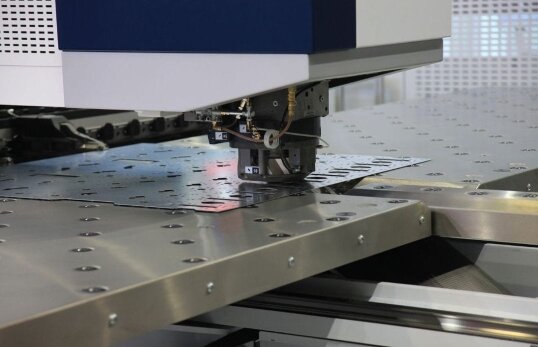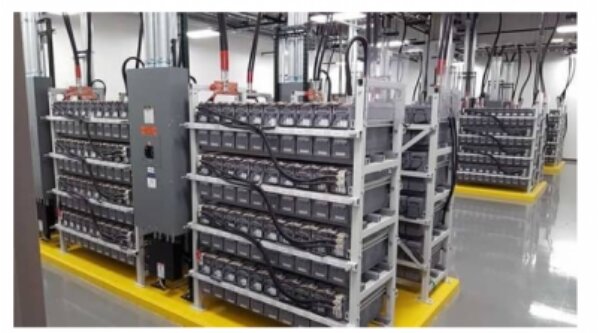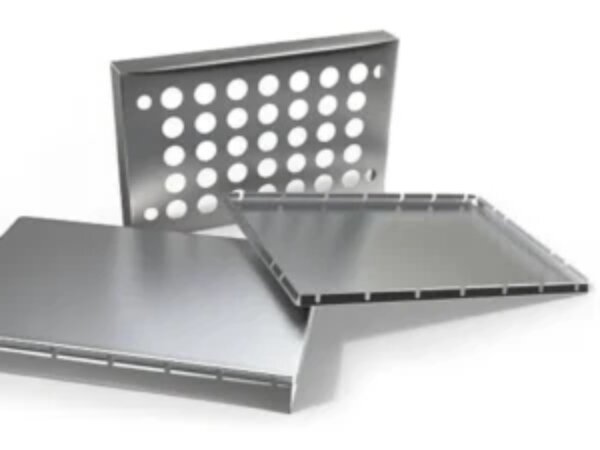If you’re looking for precise, high-quality parts in metalworking, you may have heard of CNC turning. It’s an effective manufacturing method that uses a machine to shape parts out of material. However, if you’ve never worked with CNC turning before, you might have questions about how it works and why it’s useful.
CNC turning is crucial in manufacturing because it can create parts with tight tolerances and smooth finishes. If you’re aiming for high-precision work, CNC turning offers the accuracy and repeatability needed. In the sections below, let’s explore how CNC turning works and its benefits.
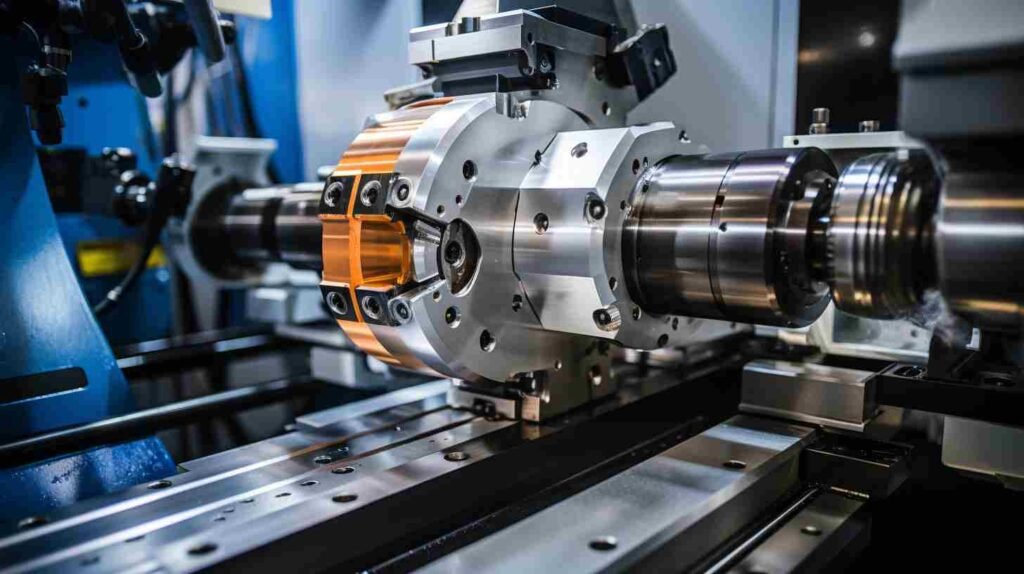
What is CNC Turning?
CNC turning is a machining process that uses a computer-controlled machine to shape materials. The workpiece is held on a rotating spindle. As it spins, a cutting tool moves along the material, removing layers to form the desired shape. The CNC system controls the movement of the tool and the cutting speed.
A CNC lathe is the main machine used in CNC turning. It holds and rotates the workpiece while the cutting tool shapes it. The CNC lathe can perform various tasks, such as facing, boring, drilling, and threading. This allows it to create complex shapes.
CNC turning is often used to make cylindrical and round parts. This includes items like shafts, pulleys, bushings, and bearings. It is ideal for creating parts with precise diameters, smooth surfaces, and tight tolerances.
How Does CNC Turning Work?
CNC turning is a precise process made up of several key steps. Here’s how it works:
1. Material Selection
The first step is choosing the right material. Metals like steel, aluminum, and brass, as well as plastics, are common materials for CNC turning.
2. Preparing the CNC Lathe
Next, the material is securely mounted onto the CNC lathe. The lathe holds the workpiece in place and rotates it at a controlled speed.
3. Programming the CNC Machine
Before turning begins, a detailed program is created. This program sets the cutting tool’s movements and speeds. It is entered into the CNC machine, which follows the program to make precise cuts.
4. Machining Process Begins
Once the machine is programmed, the cutting tool starts removing material from the rotating workpiece. The tool can move in multiple directions (along the X, Y, and Z axes) to shape the material into the desired form.
5. Fine-tuning and Quality Control
As the tool works, the operator or machine may make adjustments to ensure the part meets the required specifications.
6. Part Removal and Finishing
After the part is shaped, it is removed from the lathe. Depending on the part’s use and design, additional finishing steps, like polishing or coating, may be applied.
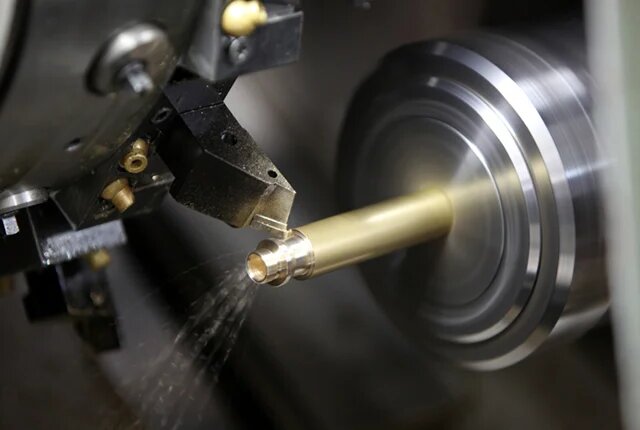
Key CNC Turning Parameters
Several important parameters must be carefully controlled to ensure the success of CNC turning. These factors affect the efficiency, quality, and accuracy of the machining process. Here are the key CNC turning parameters:
Cutting Speed
Cutting speed refers to how fast the cutting tool moves along the material’s surface. It is measured in meters per minute (m/min). The ideal speed varies depending on the material and the tool used.
Feed Rate
Feed rate is the speed at which the cutting tool moves into the material during turning. It is usually measured in millimeters per revolution (mm/rev). A higher feed rate speeds up production, but it may reduce the quality of the surface finish.
Depth of Cut
The depth of cut is the amount of material the cutting tool removes in one pass. It is measured in millimeters (mm). A deeper cut removes more material, but it can put extra strain on the tool and affect the finish.
Tool Material and Geometry
Common tool materials include carbide, high-speed steel (HSS), and ceramic. The tool’s shape, such as the cutting edge angle and rake angle, affects cutting efficiency and the part’s surface finish.
Spindle Speed
Spindle speed is how fast the workpiece rotates on the CNC lathe. It is measured in revolutions per minute (RPM). The right spindle speed ensures good cutting conditions, balances speed, and precision, and avoids too much heat.
Types of CNC Turning Machines
CNC turning machines come in different types, each designed for specific tasks. The choice of machine depends on factors like part size, complexity, and production needs. Here are the main types of CNC turning machines:
Horizontal CNC Lathes
Horizontal CNC lathes are the most common type. The spindle is mounted horizontally, and the workpiece rotates along a horizontal axis. These machines are typically used for larger, heavier parts and can work with a wide range of materials.
Vertical CNC Lathes
Vertical CNC lathes have a vertical spindle, and the workpiece is mounted vertically on the machine. This design allows better access to certain parts, especially larger ones that require heavier cutting.
Horizontal Turning Centers
Horizontal turning centers combine the features of a CNC lathe with extra capabilities, like automatic tool changers and multi-axis operations. These machines are used for more complex parts that require multiple steps. They can perform turning, milling, drilling, and tapping in one setup.
Vertical Turning Centers
Vertical turning centers are similar to horizontal turning centers but with a vertical spindle. These machines are great for producing large, heavy, or complex parts that need precise turning.
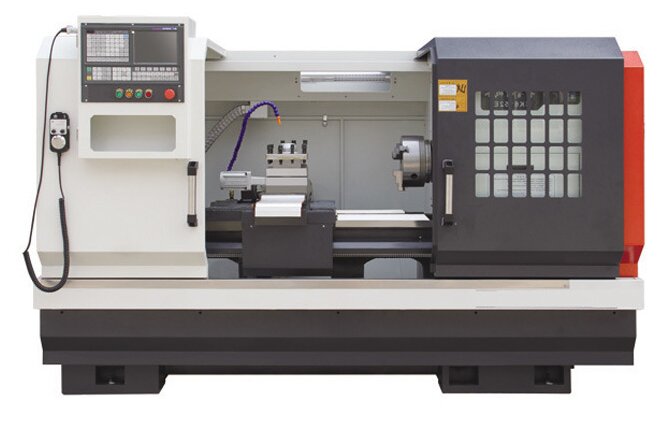
Materials Used in CNC Turning
CNC turning is a versatile process that can work with a wide variety of materials. The choice of material plays a critical role in determining the performance, durability, and cost-effectiveness of the finished part. They include:
- Metals
- Plastics
- Wood
- Glass
- Composites
Key Components of a CNC Turning Machine
CNC turning machines have several key components that work together to perform precise turning tasks. Here’s an overview of the essential elements of a CNC turning machine:
CNC Control Panel
The CNC control panel is the interface between the operator and the machine. It lets the operator program, monitor, and control the machining process.
Spindles
The spindle is the rotating part of the CNC lathe that holds and turns the workpiece. A motor powers it and spins the material at a controlled speed.
Headstocks
The headstock, located at the front of the machine, holds the main spindle and supports the rotating workpiece. It includes the motor and drive components that control the spindle’s movement.
Tailstocks
The tailstock is positioned at the opposite end of the headstock and supports the workpiece, especially during the machining of longer parts. It typically holds a center or live tooling to maintain the stability and alignment of the material as it rotates.
Beds
The bed is the base of the CNC turning machine. It supports all other components and keeps the machine stable during operation.
Chucks
The chuck is a steel clamping device that holds the workpiece in place on the spindle. Its jaws grip the material securely during machining.
Carriages
The carriage moves the cutting tool along the material to remove material in specific patterns. It holds the tool holder and allows precise positioning of the tool along the X and Z axes.
Cutting Tools
Cutting tools are used to remove material from the workpiece. They come in different shapes and sizes, depending on the task. Common cutting tools used in CNC turning include turning tools, drills, boring bars, and threading tools.
Tool Turrets
The tool turret holds multiple cutting tools and allows automatic tool changes during machining. This feature improves efficiency by reducing downtime.
Foot Pedals
Foot pedals control certain aspects of the CNC turning machine, such as starting or stopping the machine, activating the chuck, or adjusting the feed rate.
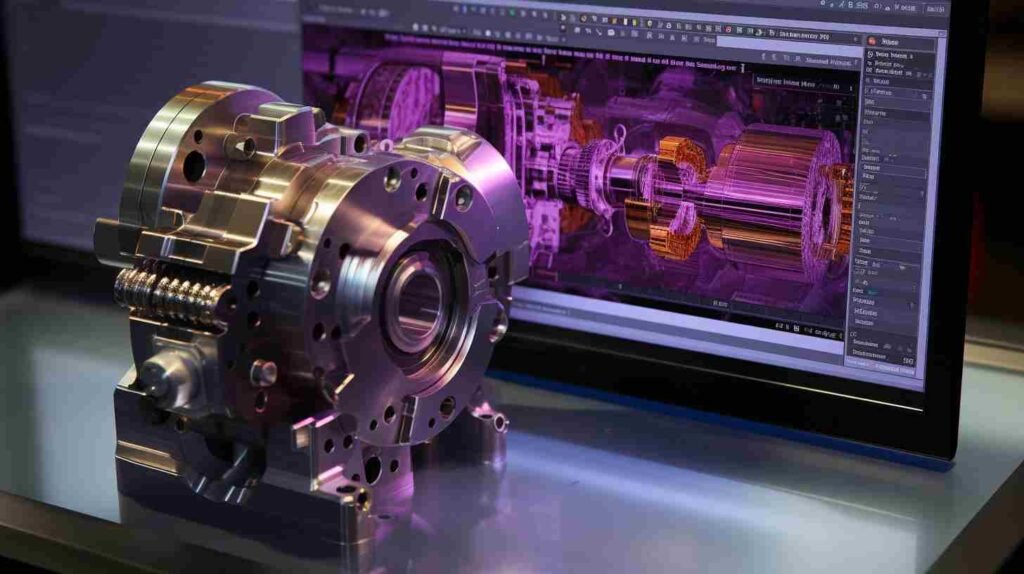
Understanding CNC Turning Operations
CNC turning offers a variety of operations to shape and finish parts with high precision. Below are the most common CNC turning operations:
Straight Turning
Straight turning is the simplest operation in CNC turning. In this process, the cutting tool moves parallel to the workpiece’s axis to remove material and create a cylindrical shape. This operation is often used to reduce the diameter of the workpiece, making parts like shafts, rods, and tubes with a uniform diameter.
Knurling
Knurling is a process that creates a textured pattern on the surface of the workpiece. This is typically done to provide a better grip, such as on handles or knobs. The knurling tool presses into the material to form a pattern of crisscrossing lines or diamonds.
Threading
Threading involves creating spiral grooves, or threads, on the workpiece’s surface. This operation is used to make parts like bolts, screws, and nuts. The cutting tool moves in a helical pattern along the surface, ensuring that the threads are precise and consistent.
Parting
Parting is used to separate the workpiece into two or more parts. The parting tool cuts at the end of the workpiece to divide it. This operation is often done at the end of the turning process when the part is ready to be removed from the machine.
Grooving
Grooving is the process of cutting a narrow groove or channel along the surface of the workpiece. The cutting tool moves to create a specific width and depth of the groove. This operation is used for features like O-ring grooves or slots in parts that require extra functionality.
Taper Turning
Taper turning creates a conical shape by gradually reducing the diameter of the workpiece along its length. The cutting tool is angled to remove material in a controlled way, forming a smooth, tapered surface. This operation is often used for parts like shafts with tapered ends or for creating conical bushings.
Key Considerations for Choosing CNC Turning
When deciding if CNC turning is the right process for your project, several key factors need to be considered. Here are the most important considerations:
Material Selection
The material you choose for CNC turning affects both the machining process and the final part. Different materials have varying hardness, machinability, and durability, which impact the choice of tools, cutting speeds, and feed rates.
Tolerance
Tolerance is the allowable variation in a part’s dimensions. CNC turning can achieve very tight tolerances, often within a few thousandths of an inch. The tighter the tolerance, the more precise the machine and tools must be. Consider the required tolerance for your part, as it will affect the time and cost of machining.
Part Geometry
Part geometry refers to the shape and complexity of the part. Simple, cylindrical parts are best for CNC turning since the process works well with rotational symmetry. More complex shapes, like intricate grooves, threading, or tapered surfaces, may need multiple operations or extra steps.
Surface Finish
CNC turning can achieve a range of finishes, from rough to smooth. A smoother finish is usually needed for parts that will touch other components or need an appealing look. Factors like cutting speed, feed rate, tool material, and cutting fluid affect the surface finish.
Benefits of CNC Turning
CNC turning offers several advantages that make it a preferred method for producing high-quality parts. Here are the key benefits of using CNC turning in manufacturing:
High Precision and Accuracy
CNC turning machines are known for producing parts with very tight tolerances. The computer-controlled process ensures each part is made with high accuracy, reducing human error and ensuring consistency across multiple parts.
Flexibility in Material Processing
CNC turning can work with a wide range of materials, from metals like steel, aluminum, and brass to plastics and composites. This flexibility makes CNC turning suitable for many industries and applications.
Efficiency and Cost-Effectiveness
CNC turning is highly efficient, especially when making large quantities of parts. Once programmed, the machine can run continuously with little human intervention, which reduces labor costs and production time.
Ability to Handle Complex Shapes
CNC turning is not limited to simple cylindrical shapes. These machines can create complex geometries, such as threading, tapering, grooving, and intricate contours.
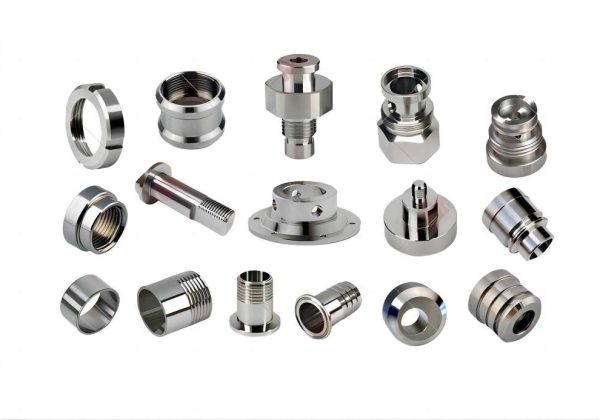
Applications of CNC Turning
CNC turning creates precision cylindrical parts for nearly every industry. Here’s where you’ll find these machined components in action:
Aerospace Industry
- Aircraft engine shafts and bushings
- Landing gear components
- Hydraulic system fittings
- Fuel system nozzles and valves
- Lightweight aluminum and titanium fasteners
Automotive Industry
- Engine valves and pistons
- Transmission shafts and gears
- Wheel hubs and brake components
- Steering system parts
- Turbocharger housings
Medical Devices and Equipment
- Surgical instrument handles
- Implant components (hip/knee joints)
- Dental drill bits and implants
- MRI machine parts
- Precision syringe pumps
Electronics Manufacturing
- Connector pins and sockets
- Heat sink components
- Semiconductor wafer chucks
- Waveguide components
- Precision spacers and insulators
CNC Turning vs. CNC Milling: Key Differences
CNC turning and CNC milling are both important machining processes used in manufacturing, but they operate differently. Here’s a breakdown of the key differences:
Basic Operation
In CNC turning, the workpiece is held and rotated on a spindle while the cutting tool stays stationary or moves along a linear path to remove material. This process is mainly used for cylindrical or round parts.
In CNC milling, the workpiece remains stationary while the cutting tool rotates and moves along multiple axes (X, Y, and Z) to remove material. Milling is more versatile and can create complex shapes, including flat, sloped, and intricate geometries.
Type of Parts Produced
CNC turning is ideal for parts with rotational symmetry, such as shafts, tubes, and pulleys. It is primarily used to create cylindrical parts with precise diameters.
CNC milling can produce a wide range of shapes, including flat, 3D, and irregular geometries. It is commonly used to create parts like brackets, gears, and complex 3D shapes with various features.
Tool Motion
In CNC turning, the cutting tool moves along a linear axis (usually the Z-axis) or along radial paths relative to the rotating workpiece. This motion is generally simpler and focused on the outer diameter.
In CNC milling, the cutting tool moves along multiple axes (X, Y, Z), allowing it to create a wide variety of shapes. This movement provides more flexibility and complexity in part design.
Material Removal
In CNC turning, the material is removed radially from the workpiece, making it ideal for parts that need smooth cylindrical surfaces or reductions in diameter.
In CNC milling, material is removed through a rotating tool that approaches the workpiece from multiple angles. This makes milling ideal for creating features like holes, slots, pockets, and intricate surface patterns.
Shengen’s CNC Turning Capability
Shengen provides full CNC turning services, specializing in both rapid prototyping and high-volume production. With over ten years of experience, Shengen can handle a variety of materials and complex designs, ensuring precision and quality in every project.
Shengen follows ISO 9001:2015 standards, ensuring consistent quality across all projects. The company applies strict quality control measures throughout the CNC turning process, from initial design to final inspection, ensuring that each part meets the required specifications.
Upload your CAD files today to receive an instant quotation.
Conclusion
CNC turning is a key process in modern manufacturing. It offers high precision, efficiency, and versatility. Whether you need simple cylindrical parts or complex shapes, CNC turning can meet a wide range of production needs.
When selecting a CNC turning service, consider factors such as material options, machine capabilities, lead times, and the provider’s expertise. Making informed decisions based on these factors helps ensure the success of your project.
Hey, I'm Kevin Lee

For the past 10 years, I’ve been immersed in various forms of sheet metal fabrication, sharing cool insights here from my experiences across diverse workshops.
Get in touch

Kevin Lee
I have over ten years of professional experience in sheet metal fabrication, specializing in laser cutting, bending, welding, and surface treatment techniques. As the Technical Director at Shengen, I am committed to solving complex manufacturing challenges and driving innovation and quality in each project.

